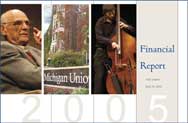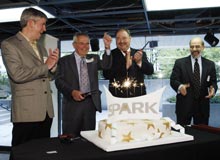

Innovation is the engine of economic development, and new ideas drive business growth and improvements in our quality of life. U-M continues a steady progress in transferring these innovative technologies to the marketplace:
U-M has pledged up to $1 million over five years to support business, university, government, and community leaders who have banded together to form SPARK—an economic development and marketing organization.
 Pictured (right) at the grand opening are SPARK Chairman Rick Snyder, CEO and founder of Ann Arbor-based Ardesta; Washtenaw County Administrator Robert Guenzel; Michigan Lt. Governor John Cherry Jr.; and
U-M Vice President for Research Fawwaz Ulaby.
Pictured (right) at the grand opening are SPARK Chairman Rick Snyder, CEO and founder of Ann Arbor-based Ardesta; Washtenaw County Administrator Robert Guenzel; Michigan Lt. Governor John Cherry Jr.; and
U-M Vice President for Research Fawwaz Ulaby.
SPARK’s goal is to double the number of technology companies and triple the number of tech jobs by 2010, making the Ann Arbor region a hub of entrepreneurial energy. SPARK is aimed at high-tech companies built on innovation, including biotech, IT, small tech, energy, advanced manufacturing, and security.
Organizers say the idea has caught fire. In less than six months it has garnered commitments of more than $2 million toward a $3 million, three-year operating goal, and has additional informal pledges exceeding this target.
SPARK will offer four primary services: business acceleration, business outreach, talent development, and regional marketing and events. A community-wide celebration of the launch of SPARK took place May 26 in downtown Ann Arbor.
The Regents approved the new Michigan Nanotechnology Institute for Medicine and the Biological Sciences at its monthly meeting in April. The Institute will merge academic expertise and institutional resources across the University to develop and market applications for nanotechnology in medicine, biological sciences, and the environment.
“This will put us on the national map in the development of core nanotechnologies for the life sciences,” said U-M President Mary Sue Coleman. “We are creating a strategic alignment of U-M’s nanoscientists as we strive to expand our research activities in this arena.”
The first test in humans of a bioartificial kidney offers hope of the device’s potential to save the lives of people with acute renal failure, researchers at the U-M Health System reported in the October 2004 issue of the journal Kidney International.
“It’s a small study, but it was compelling enough for us and the FDA to agree to go forward with a full phase II study,” says lead study author H. David Humes, MD, professor of internal medicine at the Medical School. Humes developed the renal tubule assist device, or RAD, the cell cartridge that is key to the bioartificial kidney. The RAD is being developed for future commercial applications under license to Nephros Therapeutics, Inc.
Four national leaders in entrepreneurship, technology transfer, and venture capital investment have joined Tech Transfer’s National Advisory Board. The four new members are Richard Douglas, senior vice president for corporate development at Genzyme in Cambridge, Massachusetts; Carl Stjernfeldt, partner, Battery Ventures in Wellesley, Massachusetts; Jack Turner, associate director of the Technology Licensing Office at the Massachusetts Institute of Technology; and Tom Washing, partner, Sequel Venture Partners in Boulder, Colorado.